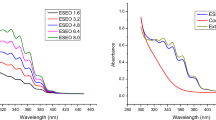Abstract
Acer Truncatum Bunge is a woody plant of the maple family unique to China that produces oil containing 5‒7% nervonic acid, which has various uses in medicine. This work demonstrates the extraction of nervonic acid ethyl ester from the oil of this plant using urea inclusion. In the case of the urea inclusion solid, there is no new peaks found in SEM image and just a superposition of those expected peaks representing urea and fatty acid ethyl esters can be observed, indicating that the interaction force between urea and fatty acid ethyl esters was just intermolecular forces rather than chemical reaction. A 95% ethanol solution was determined to be the optimum solvent for this process. Urea inclusion was found to separate various fatty acid esters with decreasing efficiency in the order of lignoceric acid > behenic acid > arachidic acid > stearic acid > nervonic acid > palmitic acid > erucic acid > cis-11-eicosenoicacid > oleic acid > linoleic acid > linolenic acid. In the optimized process, ethyl esters of cis-11-eicosenoicacid, oleic acid, linoleic acid and linolenic acid were removed from the oil via a two-stage urea inclusion mechanism that also removed sterols and other substances. Ethyl esters of arachidic acid, behenic acid and lignoceric acid were subsequently separated through a third-stage urea inclusion step. After six extractions, the product contained erucic acid and nervonic acid ethyl esters with a nervonic acid ethyl ester proportion of 52.4%. Characterization by infrared spectroscopy confirmed that the product was free of residual urea.











Similar content being viewed by others
References
Fan Y, Yuan C, ** Y, Hu GR, Li FL (2018) Characterization of 3-ketoacyl-coA synthase in a nervonic acid producing oleaginous microalgae Mychonastes afer. Algal Res 31:225–231
Farquharson J, Jamieson EC, Logan RW, Patrick WJA, Howatson AG, Cockburn F (1996) Docosahexaenoic and nervonic acids in term and preterm infant cerebral white matter. Prenat Neonat Med 42:234–240
Lin XC, Wang JZ, Wu JY (2008) Physicochemical properties of Vitex negundo seed oil and the isolation of its nervonic acid. China Oils Fats 33(10):37–39
Ma QY, Sun TL, Li SS, Wen J, Zhu L, Yin TM, Yan KY, Xu X, Li SX, Mao JF, Wang YN, ** SX, Zhao X, Li QZ (2020) The Acer truncatum genome provides insights into nervonic acid biosynthesis. Plant J 104(3):662–678
Martínez M, Mougan I (1998) Fatty acid composition of human brain phospholipids during normal development. J Neurochem 71:2528–2533
Merrill AH, Schmelz EM, Wang E, Dillehay DL, Rice LG, Meredith F, Riley RT (1997) Importance of sphingolipids and inhibitors of sphingo lipidmetabolism as components of animal diets. J Nutr 127:830–833
Morales-Medina R, León GD, Munio M (2016) Mass transfer modeling of sardine oil polyunsaturated fatty acid (PUFA) concentration by low temperature crystallization. J Food Eng 183:16–23
Poulos A (1995) Very long chain fatty acids in higher animals: a review. Lipids 30:1–14
Qiao Q, Wang X, Ren HJ, An K, Feng Z, Cheng TT, Sun ZK (2019) Oil content and nervonic acid content of Acer truncatum seeds from 14 regions in China. Hortic Plant J 5(1):24–30
Qiao Q, Xue W, Feng Z (2018) Variability of seed oil content, fatty acid composition, and nervonic acid content in Acer truncatum, native to 14 regions of China. Grasas Aceites 69(4):e274
Sargent JR, Coupland K, Wilson R (1994) Nervonic acid and demyelinating disease. Med Hypotheses 42:237–242
Wang RK, Fan JS, Chang P, Zhu L, Zhao MR, Li LL (2019) Genome survey sequencing of Acer truncatum Bunge to identify genomic information, simple sequence repeat (SSR) markers and complete chloroplast genome. Forests 10(2):87
Wang RK, Liu P, Fan JS, Li LL (2018) Comparative transcriptome analysis two genotypes of Acer truncatum Bunge seeds reveals candidate genes that influences seed VLCFAs accumulation. Sci Rep-UK 8(1):15504
Xu WH, Wang JR, Liang Q (2017) Separation of nervonic acid from Acer Truncatum buge oil. China Oils Fats 32(11):49–51
Zhang Y, Hou XL (2010) Separation and purification of nervonic acid ethyl ester from Acer truncatum Bunge seed oil. China Oils Fats 35(1):28–31
Zhao Y, Zhu J, Wang XD (2016) Purification of Acer truncatum nervonic acid by high-speed countercurrent chromatography. Food Sci Tech 41(6):251–254
Zheng ZX, Dai ZY, Shen Q (2018) Enrichment of polyunsaturated fatty acids from seal oil through urea adduction and the fatty acids change rules during the process. J Food Process Pres 42(5):e13593
Acknowledgements
This work was supported by the National Natural Science Foundation of China (22125802, and 22078010) and Big Science Project from BUCT (XK180301). The authors gratefully acknowledge these grants. We thank Liwen Bianji (Edanz) (https://www.liwenbianji.cn) for editing the language of a draft of this manuscript.
Author information
Authors and Affiliations
Corresponding authors
Ethics declarations
Conflict of interest
The authors declare that they have no conflict of interest.
Additional information
Publisher's Note
Springer Nature remains neutral with regard to jurisdictional claims in published maps and institutional affiliations.
Rights and permissions
Springer Nature or its licensor (e.g. a society or other partner) holds exclusive rights to this article under a publishing agreement with the author(s) or other rightsholder(s); author self-archiving of the accepted manuscript version of this article is solely governed by the terms of such publishing agreement and applicable law.
About this article
Cite this article
Shi, J., Wang, J., Gao, Y. et al. Extraction of nervonic acid from Acer truncatum oil by urea inclusion. Chem. Pap. 77, 5701–5711 (2023). https://doi.org/10.1007/s11696-023-02890-5
Received:
Accepted:
Published:
Issue Date:
DOI: https://doi.org/10.1007/s11696-023-02890-5




